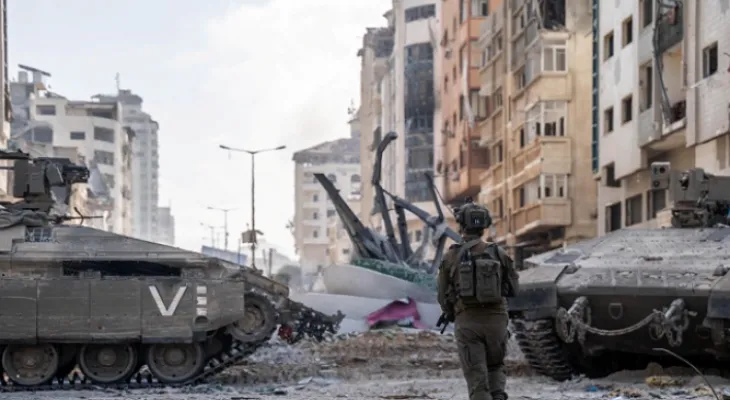Search here
Newspaper
Search here

Arab Canada News
News

Published: June 19, 2024
Amid the sound of drums of a regional war accelerating in pace, and with fears about its implications for the fate of the Middle East, came the fourth tour of the American presidential envoy Amos Hochstein to the region since October 7th.
As soon as this tour ended, indicators of failure became evident regarding its intended goal, which was to contain the escalation between Israel and Hezbollah and to prevent an "even larger war" in a region already burdened by conflicts.
After hours of his visit to Israel and meeting a number of its officials, including those in power headed by Prime Minister Benjamin Netanyahu and Defense Minister Yoav Gallant, as well as opposition figures represented by Yair Lapid and Benny Gantz, the American envoy visited Lebanon and met several of its officials, notably the caretaker Prime Minister Najib Mikati, Speaker of the House Nabih Berri, and Army Chief Joseph Aoun. However, the results were contrary to hopes, according to observers.
The Hoopoe in the Sky of Israel
After a calm period on his part that lasted more than 48 hours during which no operations were carried out against Israeli targets, Hezbollah resumed its operations yesterday, Tuesday, coinciding with Hochstein's visit to Beirut. It even introduced something new by broadcasting a video clip that it claimed was obtained via a drone called "The Hoopoe," which penetrated Israeli airspace and captured images of strategic and sensitive sites in Haifa, northern Israel, raising questions about how this drone reached these areas and filmed so easily for about 10 minutes before returning to Lebanon without any reaction from the Israeli army.
This footage caused a state of confusion within Israel, with Hebrew media describing the content of this video as dangerous and the most concerning since the war began, considering the release of such footage as boasting by Hezbollah and carrying direct messages about the party's ability to reach deep into Israel if the almost daily confrontations between it and Israel escalate into a broader war.
While the occupation army seemed to attempt justifying itself amidst a wave of escalating criticism, it talked about tracking four drones belonging to Hezbollah during the past week "which seem to be intended for gathering information and filming."
It added that "two drones were intercepted, and there was a third drone whose path could not be tracked, while a fourth drone was deliberately not intercepted to avoid alarm sirens going off in the entire surrounding area."
The Israeli army continued: "Drones intended for gathering information and filming are difficult to track and intercept because they are smaller in size and do not carry explosives."
A War like None We Have Known
The army acknowledged that the release of these clips affects its image, emphasizing that it is continuously working to enhance its interception capabilities and also to target cells belonging to Hezbollah's air unit, according to what the army radio reported.
Yedioth Ahronoth newspaper followed the same path, stating that "the Israeli aerial surveillance system tracked the Hoopoe drone and did not intercept it because it did not pose a threat and out of fear that downing it could cause injuries."
Amid calls for an investigation into what was termed failures, starting from the failure to respond to the attacks of October 7 and thwarting them, passing through the failure to realize the declared objectives of the war despite entering its ninth month, culminating in what was tracked by the "Hoopoe drone," the Israeli Defense Minister asserted that "the difficult war we are fighting was a surprise, and we have paid a heavy price like none we have seen before."
Gallant added: "The painful failure will be discussed and learned from, and these lessons will affect our future on this land... The army, Mossad, and security agencies are fighting on seven fronts for the past eight months, and this is a war like none we have known."
For his part, Israeli Foreign Minister Israel Katz warned of escalating tensions in the northern part of the country, saying in a post on the social media platform (X): "We are very close to a decision moment to change the rules against Hezbollah and Lebanon," adding: "In a full-scale war, Hezbollah will be destroyed, and Lebanon will be severely affected."
The Times of Israel estimated the toll of the almost daily skirmishes on the Israeli-Lebanese border so far at 10 civilian deaths on the Israeli side, in addition to the death of 15 soldiers and reservists in the Israeli army.
Meanwhile, the newspaper noted that Hezbollah announced the names of 343 of its members who were killed by Israel, most of them in Lebanon, but some also in Syria.
Offensive Plans in Lebanon
On the other hand, the Israeli army stated that senior generals approved the offensive battle plans in Lebanon "and also made decisions regarding accelerating the readiness of ground forces while fighter jets bomb Hezbollah targets."
These developments coincide with increasing internal pressures on Netanyahu's government, along with rising voices demanding not to drag Israel into a multi-front war, particularly in light of what Hebrew media described as a state of exhaustion suffered by the Israeli army amidst the ongoing Gaza war for more than eight months.
Observers believe that these developments will increase internal confusion, especially since they come after a report by the Israeli Public Broadcasting Corporation (Kan) that indicated Israeli military intelligence issued clear warnings about an imminent attack more than two weeks before the Hamas attack on October 7 of last year, but senior officers in the Israeli army's "Gaza Division" ignored it, raising additional questions that need to be clarified.
Analysts see that given these indicators, it seems that the region is heading towards hotter days, and things may drift towards the most dangerous scenario of a regional war with direct involvement from several parties.
Comments